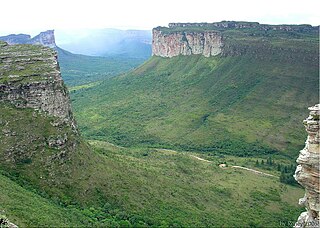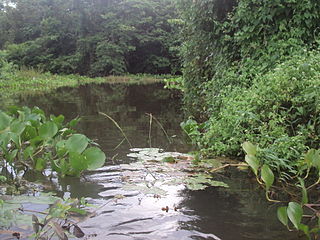
The Chapada Diamantina National Park is a national park in the Chapada Diamantina region of the State of Bahia, Brazil. The terrain is rugged, and mainly covered by flora of the Caatinga biome.

Serra da Canastra National Park is a national park in the Canastra Mountains of the state of Minas Gerais, Brazil.

The Ubajara National Park is a national park in the state of Ceará, Brazil. It is the smallest of the 35 national parks of Brazil and is known for the Ubajara grotto.

Lagoa do Peixe National Park is a national park in the state of Rio Grande do Sul, Brazil. It was created in 1986 to protect a wintering zone for migratory birds along the Lagoa dos Patos, the estuary of the Guaiba river or Guaíba Lake about 200 kilometres (120 mi) south of Porto Alegre.

The Pantanal Matogrossense National Park is a national park in the state of Mato Grosso at the border to Mato Grosso do Sul, Brazil.

Serra Geral National Park is a national park in the states of Rio Grande do Sul and Santa Catarina, Brazil.

The Serra do Pardo National Park is a National park in the state of Pará, Brazil.

Nascentes do Rio Parnaíba National Park is a national park of Brazil.

The Catimbau National Park is a national park in the state of Pernambuco, Brazil. It protects a semi-arid area of caatinga with sandstone caverns and caves in which prehistoric art has been found.

Serra da Bodoquena National Park is a national park in the state of Mato Grosso do Sul, Brazil.

Saint-Hilaire/Lange National Park is a national park in Paraná, Brazil.

Anavilhanas National Park is a national park that encompasses a huge river archipelago in the Rio Negro in the state of Amazonas, Brazil. It is part of a World Heritage Site.

Cairuçu Environmental Protection Area is a protected area in the south of Rio de Janeiro state, Brazil. It contains an important remnant of the Atlantic Forest biome.
The Rio São Francisco Natural Monument is a natural monument in the states of Alagoas, Bahia and Sergipe, Brazil. It protects a section of dramatic canyons on the São Francisco River and the surrounding caatinga environment, while supporting tourism and ecotourism.

Rio Novo National Park is a national park in the state of Pará, Brazil.
The Açu National Forest is a national forest in the state of Rio Grande do Norte, Brazil.
Nísia Floresta National Forest is a national forest in the state of Rio Grande do Norte, Brazil.

The Serra das Confusões National Park is a national park in the state of Piauí, Brazil.

Serra do Gandarela National Park is a national park in the state of Minas Gerais, Brazil. It protects a mountainous region holding a remnant of Atlantic Forest that is an important source of water for the city of Belo Horizonte.

The Guaricana National Park is a national park in the state of Paraná, Brazil. It protects a mountainous area holding a remnant of Atlantic Forest.


















